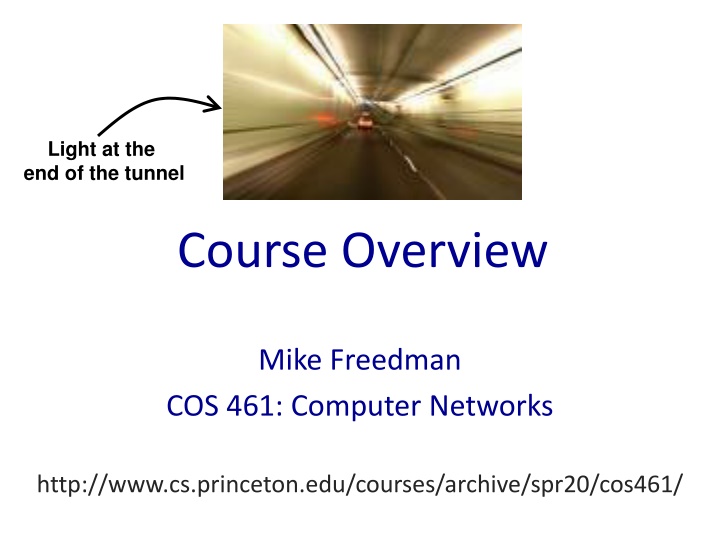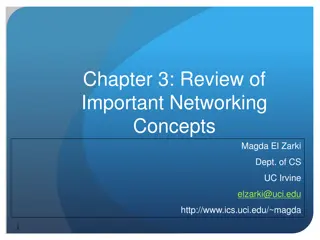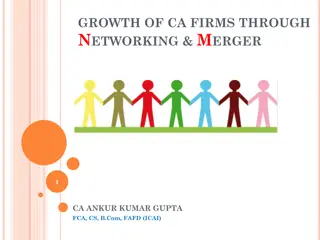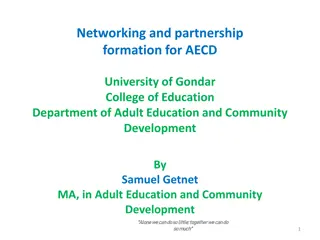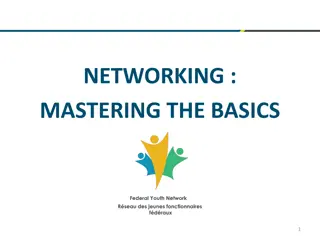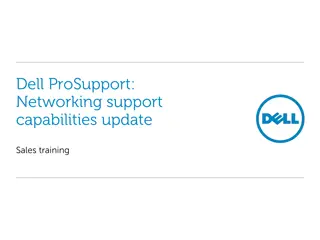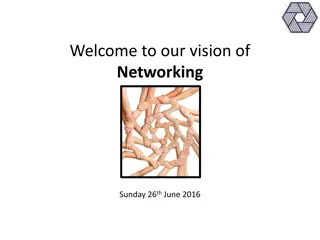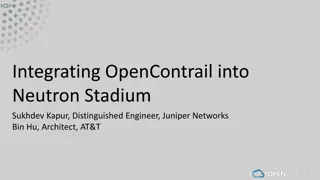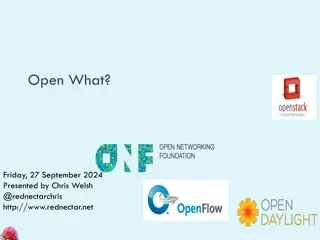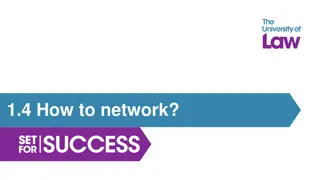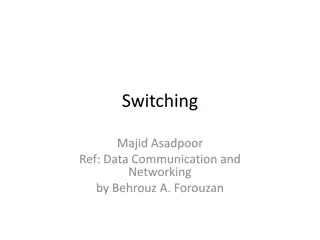Networking Concepts Overview
This content provides an overview of key concepts in computer networking, including hierarchy, indirection, caching, and more. It discusses the organization of networks, scalability challenges, IP addressing, routing protocols, and interdomain routing. The visuals and explanations help in understanding fundamental networking principles.
Uploaded on Mar 06, 2025 | 1 Views
Download Presentation

Please find below an Image/Link to download the presentation.
The content on the website is provided AS IS for your information and personal use only. It may not be sold, licensed, or shared on other websites without obtaining consent from the author.If you encounter any issues during the download, it is possible that the publisher has removed the file from their server.
You are allowed to download the files provided on this website for personal or commercial use, subject to the condition that they are used lawfully. All files are the property of their respective owners.
The content on the website is provided AS IS for your information and personal use only. It may not be sold, licensed, or shared on other websites without obtaining consent from the author.
E N D
Presentation Transcript
The%2520Light%2520at%2520the%2520End%2520of%2520the%2520TunnelThe%2520Light%2520at%2520the%2520End%2520of%2520the%2520Tunnel Light at the end of the tunnel Course Overview Mike Freedman COS 461: Computer Networks http://www.cs.princeton.edu/courses/archive/spr20/cos461/
2 Key Concepts in Networking
Some Key Concepts Course was organized around protocols But a small set of concepts recur in many protocols General CS concepts Hierarchy, indirection, caching, randomization Networking-specific concepts Soft state, layering, (de)multiplexing End-to-end argument
Hierarchy Scalability of large systems Cannot store all information everywhere Cannot centrally coordinate everything Hierarchy Hierarchy to manage scale Divide system into smaller pieces Hierarchy to divide control Decentralized management Examples in the Internet IP addresses, routing protocols, DNS, peer-to-peer
Hierarchy: IP Address Blocks Number related hosts from a common subnet 1.2.3.0/24 on the left LAN 5.6.7.0/24 on the right LAN 1.2.3.4 1.2.3.7 1.2.3.156 5.6.7.8 5.6.7.9 5.6.7.212 ... ... host host host host host host LAN 2 LAN 1 router router router WAN WAN 1.2.3.0/24 5.6.7.0/24 forwarding table
Hierarchy: IP Address Blocks Separation of control Prefix: assigned to an institution Addresses: assigned by institution to its nodes Who assigns prefixes? Internet Corporation for Assigned Names & Numbers Regional Internet Registries (RIRs) Internet Service Providers (ISPs) Stub networks Regions within an enterprise
Hierarchy: Routing Protocols AS-level topology Nodes are Autonomous Systems (ASes) Edges are links and business relationships Hides the detail within each AS s network 4 3 5 2 6 7 1 Client Web server
Hierarchy: Routing Protocols Interdomain routing ignores details in an AS Routers flood information to learn the topology Routers determine next hop to other routers By computing shortest paths based on link weights 2 1 3 1 3 2 1 5 4 3
9 Hierarchy: Domain Name System 13 root servers (see http://www.root-servers.org/) Labeled A through M A Verisign, Dulles, VA C Cogent, Herndon, VA (also Los Angeles) D U Maryland College Park, MD G US DoD Vienna, VA H ARL Aberdeen, MD J Verisign, ( 11 locations) K RIPE London (also Amsterdam, Frankfurt) I Autonomica, Stockholm (plus 3 other locations) E NASA Mt View, CA F Internet Software C. Palo Alto, CA (and 17 other locations) m WIDE Tokyo B USC-ISI Marina del Rey, CA L ICANN Los Angeles, CA
Hierarchy: Domain Name System unnamed root zw arpa uk com edu org ac generic domains country domains in- addr bar ac west east 12 cam foo my 34 usr my.east.bar.edu usr.cam.ac.uk 56 12.34.56.0/24
11 Hierarchy: Super Peers in P2P (KaZaA) Each peer is either group leader or assigned to group leader TCP connection between peer and its group leader TCP connections between some pairs of group leaders Group leader tracks the content in all its children ordinary peer group-leader peer neighoring relationships in overlay network
Indirection Referencing by name Rather than the value itself E.g., manipulating a variable through a pointer Benefits of indirection Human convenience Reducing overhead when things change Examples of indirection in the Internet Names vs. addresses Mobile IP
Indirection: Names vs. Addresses Host name to IP address Mnemonic names to location-dependent addresses E.g., from www.cnn.com to 64.236.16.20 Using the Domain Name System (DNS) From IP address to MAC address From hierarchical global address to interface card E.g., from 64.236.16.20 to 00-15-C5-49-04-A9 Using the Address Resolution Protocol (ARP)
Indirection: Load Balancers & Switches Not fixed binding of IPs or MAC address to physical machine NAT allows multiple machines to share single public IP address Load balancers: Machines share IP address, LB maps to physical machine by network flow VM can migrate across L2 network through gratuitous ARP
Caching Duplicating data stored elsewhere To reduce latency for accessing the data To reduce resources consumed Caching is often quite effective Speed difference between cache and primary copy Locality of reference, and small set of popular data Examples from the Internet DNS caching, Web caching
Caching: DNS Caching Root server 3 4 Application DNS cache 5 Top-level domain server DNS query 1 6 10 Local DNS server 2 DNS resolver 7 9 DNS response 8 Second-level domain server
18 Caching: Web Caching Caching location Proxy cache Browser cache origin server Proxy server client Better performance Lower RTT Existing connection Less network load client origin server
Randomization Distributed adaptive algorithms Multiple distributed parties Adapting independently Risk of synchronization Many parties reacting at the same time Leading to bad aggregate behavior Randomization can desynchronize Ethernet back-off, Random Early Detection Rather than imposing centralized control
Randomization: Ethernet Back-off Random access: exponential back-off After collision, wait random time before retrying After mth, choose K randomly from {0, , 2m-1} Wait for K*512 bit times before trying again
Randomization: Dropping Packets Early Congestion on a link Eventually the queue becomes full And new packets must be dropped Drop-tail queuing leads to bursty loss Many packets encounter a full queue Many TCP senders reduce their sending rates
Randomization: Dropping Packets Early Better to give early feedback Get a few connections to slow down before it is too late Random Early Detection (RED) Randomly drop packets when queue (near) full Drop rate increases as function of queue length Probability Average Queue Length
Soft State State: stored in nodes by network protocols Installed by receiver of a set-up message Updated when conditions change Hard state: valid unless told otherwise Removed by receiver of tear-down message Requires error handling to deal with sender failure Soft state: invalid if not told to refresh Periodically refreshed, removed by timeout Soft state reduces complexity DNS caching, DHCP leases
Soft State: DNS Caching Cache consistency is a hard problem Ensuring the cached copy is not out of date Strawman: explicit revocation or updates Keep track of everyone who has cached information If name-to-host mapping changes, update caches Soft state solution DNS responses include a time to live (TTL) field Cached entry is deleted after TTL expires
Soft State: DHCP Leases DHCP offer message from the server Configuration parameters (proposed IP address, mask, gateway router, DNS server, ...) Lease time (the time information remains valid) Why is a lease time necessary? Client can release address (DHCP RELEASE) E.g., ipconfig /release or clean shutdown of computer But, the host might not release the address E.g., the host crashes or buggy client software You don t want address to be allocated forever
Layering: A Modular Approach Sub-divide the problem Each layer relies on services from layer below Each layer exports services to layer above Interface between layers defines interaction Hides implementation details Layers can change without disturbing other layers Application Application-to-application channels Host-to-host connectivity Link hardware
Layering: Standing on Shoulders host host HTTP message HTTP HTTP TCP segment TCP TCP router router IP packet IP packet IP packet IP IP IP IP Ethernet interface Ethernet interface SONET interface Ethernet interface Ethernet interface SONET interface Ethernet frame SONET frame Ethernet frame
Layering: Internet Protocol Suite Applications FTP HTTP NV TFTP UDP TCP TCP UDP Waist IP Data Link NET1 NET2 NETn Physical The Hourglass Model The waist facilitates interoperability
Layering: Encapsulation of Data Different devices switch different things Physical layer: electrical signals (repeaters and hubs) Link layer: frames (bridges and switches) Network layer: packets (routers) Application gateway Transport gateway Frame header Packet header TCP header User data Router Bridge, switch Repeater, hub
Demultiplexing Separating multiple streams out of one Recognizing the separate streams Treating the separate streams accordingly Examples in the Internet type port # Frame header Packet header TCP header User data protocol
31 (De)multiplexing: With a NAT 138.76.29.7 10.0.0.1 outside NAT 10.0.0.2 inside
Power at the End Host End-to-End Principle Whenever possible, communications protocol operations should be defined to occur at the end-points of a communications system. Programmability With programmable end hosts, new network services can be added at any time, by anyone.
Why No Math in This Course? Hypothesis #1: theory not relevant to Internet Body of math created for telephone networks Many of these models don t work in data networks Hypothesis #2: too many kinds of theory Queuing: statistical multiplexing works Control: TCP congestion control works Optimization: TCP maximizes aggregate utility Game: reasoning about competing ASes
What Will Happen to the Internet
No Strict Notions of Identity Leads to Spam Spoofing Denial-of-service Route hijacking 35
Protocols Designed Based on Trust That you don t spoof your addresses MAC spoofing, IP address spoofing, spam, That port numbers correspond to applications Rather than being arbitrary, meaningless numbers That you adhere to the protocol Ethernet exponential back-off after a collision TCP additive increase, multiplicative decrease That protocol specifications are public So others can build interoperable implementations
Nobody in Charge Traffic traverses many Autonomous Systems Who s fault is it when things go wrong? How do you upgrade functionality? Implicit trust in the end host What if some hosts violate congestion control? Anyone can add any application Whether or not it is legal, moral, good, etc. Spans many countries So no one government can be in charge
Challenging New Requirements Disseminating data Mobile, multi-homed hosts Sometimes-connected hosts Large number of hosts Real-time applications
The Internet of the Future Can we fix what ails the Internet Security, performance, reliability Upgradability, managability <Your favorite gripe here> Without throwing out baby with bathwater Ease of adding new hosts Ease of adding new services Ease of adding new link technologies An open technical and policy question
